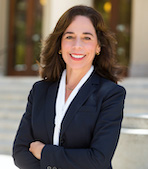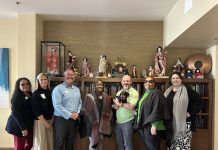By Mara W. Elliott
Every time I read about a mass shooting somewhere in America, I ask myself: Was this tragedy preventable?
The answer is usually yes. In most cases, perpetrators of mass shootings make their intentions known. Studies show that nearly 80 percent made explicit public threats — often on social media or directly to their intended targets — well in advance of the massacre. Yet in many parts of our country, those “red flags” are ignored.
In San Diego, my Office works every day to keep the unthinkable from happening. Working closely with the courts and law enforcement, our Gun Violence Response Unit acts quickly on threats of gun violence, whether it’s someone intent on suicide, a vengeful ex, or a would-be mass shooter who holds a grudge against a school or workplace. Where warranted, the Unit petitions the court for a gun violence restraining order (GVRO), a crisis intervention tool that allows law enforcement to temporarily remove access to firearms from individuals who pose a threat to themselves or to others.
In one recent case, a 25-year-old man who was disturbed by COVID closures was regularly attending “Freedom Rallies” with his infant daughter, and calling for mass violence on social media. “Protesting is not the answer,” he posted. “None of this is going to stop without bloodshed.” The morning of the next protest, police served him with a GVRO. They found he’d packed a handgun and ammo into his daughter’s diaper bag.
Another protest-related GVRO was obtained against a 32-year-old man who was posting threats on social media against Democrats and Black Lives Matter protesters. “All I want is a fight and a good death,” he wrote. “I’m ready to die. I welcome Valhalla.” (Valhalla is the Norse heaven, and a term appropriated by white supremacists.) Using a GVRO, police confiscated two unregistered AR-15s and a semi-automatic gun with a silencer.
In the three and a half years since my Office launched California’s first comprehensive GVRO program, we have intervened with a GVRO in more than 550 dangerous situations, roughly one-third involving domestic violence. Removing access to firearms from these volatile situations not only protects the immediate parties, but can prevent future violence on a larger scale. A study of 749 mass shootings found that 70 percent of the shooters were men with a history of domestic violence.
We believe our quick action saves lives. Here are just a few of the hundreds of dangerous situations in which we’ve intervened:
• A 30-year-old man rented a hotel room in downtown San Diego, across from the federal courthouse. He made videos of himself appearing to do a practice run for a mass shooting, using multiple weapons and “dry-firing” out the window at unsuspecting pedestrians below. Two assault rifles were among the 14 firearms confiscated. All firearms were purchased in the 16-month period leading up to the incident.
• A 21-year-old man posted a picture of himself holding an AR-15 rifle on social media with a message saying “RIP” to his former high school. He wrote that no one would be graduating from that zip code, and that he hoped to die.
• Multiple employees at a military tech company complained about a 60-year-old co-worker who analyzed mass shootings and bragged he would do it better. He once commented that it would be easy to do a drive-by shooting while the employees were lined up during a fire drill, and described pointing guns at his neighbors.
Family members, classmates, neighbors, and co-workers are often the first to witness potentially dangerous situations. They contact police and we obtain a GVRO before a credible threat becomes a terrifying reality.
My message to you is this: if you know someone who is exhibiting threatening, dangerous, or suicidal behavior, and they have access to guns, contact law enforcement immediately.
San Diego is one of America’s safest cities, and with your help, we can keep it that way.
San Diego Police Department’s 24-hour non-emergency number: (619) 531-2000
Call 911 in an emergency.
Mara Elliot is San Diego City Attorney.














